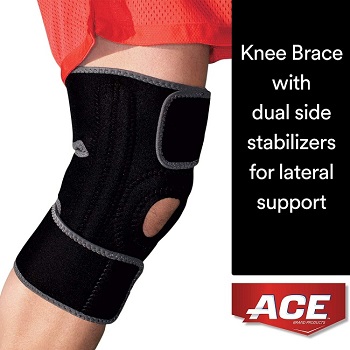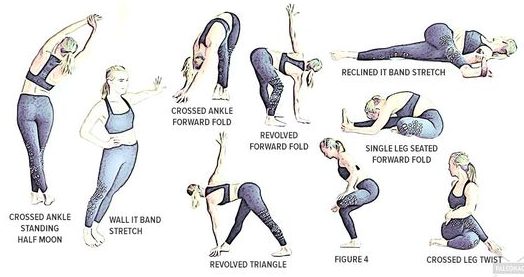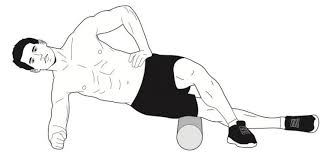Lateral knee pain or pain on the outer side of the knee may come on gradually or may develop suddenly after an injury. Outer side knee pain is common for overuse running injuries and also common in turning or twisting sports. Outer knee pain may also occur with no injury at all. Sometimes symptoms like swelling, clicking or popping might accompany pain on the outer side of the knee.
Pain on the outside of the knee may be a general ache or specific sharp pain and may be some restriction of movement. Depending on the location of your pain and associated symptoms usually determine the cause of your pain and what approach will be necessary for your knee pain management.
Lateral Knee Anatomy
The lateral compartment of the knee contains several ligamentous and tendinous structures, that are the first restraint against varus angulation and external-internal rotation, and anterior-posterior translation of the leg bone.
Although the lateral knee contains 28 distinctive structures, the primary lateral knee stabilizers embody the fibular collateral ligament, popliteus tendon, and popliteofibular (fabellofibular) ligament. Together, these structures are performed to resist lateral compartment varus gapping and rotatory knee instability.
The lateral side of the knee is stable by a complex arrangement of ligaments, tendons, and muscles. These structures offer anterolateral and posterolateral stabilization. There are 3 anatomic layers to the lateral knee-
- Layer One
- ITB
- Biceps
- Fascia
- Layer Two
- Patellar Retinaculum
- Patellofemoral Ligament
- Layer Three
- LCL
- Arcuate Ligament
- Fabellofibular Ligament
- Capsule
Lateral (outside) Knee Pain Causes & Symptoms
There are a variety of causes of lateral knee pain. It can link many of them to an injury. Some of the most common circumstances that cause knee injury and pain include falls, sports injuries, or increased activity. The following are the most frequent possible causes of lateral knee pain-
Iliotibial Band Syndrome
One of the most prevalent causes of pain on the outside of the knee is iliotibial band syndrome. We also know it as an ITBFS or runner’s knee and is common in runners, cyclists, and soldiers.
Causes: Overuse, weakness, flat feet, muscle tightness, running, and a sudden increase in activity.
Symptoms Comprise:
- Pain and inflammation on the outside of the knee.
- Symptoms are worse with running, particularly on heel strikes.
- Develop steadily, usually occurring at roughly the same time as a run.
- The pain usually lessens with rest, and only comes back when training resumes.
Lateral Collateral Ligament Sprain
A lateral ligament sprain is a knee injury involving overstretching and tearing of the ligament on the outer side of the knee.
Causes: Sudden twisting or an awkward fall where the lower leg is forced inwards or a blow to the inside of the knee.
Symptoms Includes:
- Symptoms can vary from mild to complete rupture.
- Swelling may occur on the outer side of the knee joint.
- Bruising and pain on the outer side of the knee.
- Worse when bending the knee.
- Instability
- Pain increases in walking, on stairs or with sports.
Lateral Meniscus Tear
A lateral meniscus tear is an injury to the thick cartilage lining the outer side of the knee joint. The meniscus is the semi-circular disc found in the joint. Meniscus provides cushioning and support to the knee joint. A torn meniscus can be sudden onset, acute knee injury, or it can develop gradually from wear and tear.
Causes: Sudden onset from awkward knee twisting, particularly if knee bent and foot planted. Gradual onset from wear and tear.
Symptoms Include:
- Pain along the joint line, on the outside of your knee (lateral knee pain).
- Pain may be poorer when squatting, notably deep squats.
- Difficulty in straightening the knee.
- It will swell more often than not and may also lock or give way.
- Instability
Lateral Knee Arthritis
Osteoarthritis is the wear and tear of the knee joint. This results in the degeneration of cartilage, which lines and protects the ends of your bones. Eventually, the bone will wear away. Wear and tear on the outer side of the knee joint, bone spur formation, loss of joint space, inflammation
Causes: Wear and tear, aging, previous knee injury, previous surgery on the knee and obesity.
Symptoms Comprise:
- It feels deep nagging aching pain, usually on the inside of the knee, but can also affect the outside of the knee.
- Joint swelling, stiffness (particularly in the morning) and creaky/noisy knees
- Symptoms are worse after exercise.
Hamstring Tendinopathy/Tendonitis
Damage and tearing to the lateral hamstring tendon, biceps femoris tendonitis is an inflammation of the hamstring tendon at the point where it inserts into the knee.
Causes: Overuse, repetitive jumping or kicking, sports where there is a lot of acceleration and deceleration work
Symptoms: Tender to touch, sharp posterolateral knee pain, and worse with resisted knee flexion. The pain also feels after sitting for long periods or stiffness after exercise.
Less Common Reason Behind Lateral Knee Pain
There are many other causes of lateral knee pain. These are we should not forget.
Proximal Tibiofibular Joint Dislocation
This is one of the most unusual causes of lateral knee pain. It affects the joint between the top of the shinbone (tibia) and also the fibular, the small, thin bone that runs down the outer side of the shin, slightly below the knee joint on the outer side.
It takes a large force to dislocate the joint, e.g. an automobile accident, however, it may also partly dislocate usually because of a fall once the foot is plantarflexed (toes pointing down), which frequently also damages the tibiofibular ligament.
Symptoms typically include lateral knee pain, instability, particularly during deep squats, and sometimes a clear deformity at the side of the knee. There is also injury to the peroneal nerve resulting in pins and needles or symptoms around the outer knee.
Slipped Capital Femoral Epiphysis
A Slipped capital femoral epiphysis may be a hip injury more common in boys aged 11 to 16 years old. A fracture happens of the growth plate within the thigh bone (femur) develops gradually causing pain within the hip, which can radiate to the outside of the knee.
Perthes’ Disease
Perthes’ disease is a hip condition that affects youngsters, most ordinarily aged between four and eight. Symptoms of tiredness and groin pain are common, and therefore the patient may additionally have a noticeable limp. If Perthes’ disease is suspected then seek medical advice as soon as possible because early intervention is important to prevent future issues.
Nerve Issues
Pressure on the path of the peroneal nerve may also cause outer knee pain. The peroneal nerve branches off from the sciatic nerve and runs down the outer aspect of the lower leg to the foot. It typically associates nerve pain with tingling, pins and needles, and numbness.
Damage to the peroneal nerve sometimes happens once there’s a blow to the aspect of the knee that squashes the nerve where it sits just under the skin. instead, there could also be pressure in a higher place the nerve where the sciatic nerve branches off from the lower part of the lumbar spine e.g. from a disc protrusion.
The pain will refer (travel) down the nerve and will cause lateral knee pain, with or without associated back pain. Again, there’ll typically be neurological symptoms like tingling and/or numbness.
Pain When Move
- Outside Knee Pain When Running: The foremost reason for outside knee pain running is ITB syndrome. With ITBS, it is necessary to rest from aggravating activities; Otherwise, the condition will become chronic. This might mean reducing training time or stopping running altogether for a while.
- Outside Knee Pain No Swelling: Outside of knee pain no swelling implies an overuse or chronic condition like tendinopathy, ITBS or runners knee, instead of a soft tissue injury like a ligament sprain or meniscus tear.
- Lateral Knee Pain on Flexion: Outer knee pain when bending the knee typically indicates a problem within the hamstrings as they’re responsible for knee flexion.
- Lateral Knee Pain with Full Extension: Pain on the outside of the knee once you straighten the leg is usually caused by something getting stuck within the knee joint, usually from a cartilage injury or arthritis.
- Knee Pain While Lateral When Squatting: This happens once there’s a problem within the knee cartilage which means it does not give adequate padding of the knee joint, generally a meniscus tear and knee arthritis
- Lateral Knee Pain Going Down Stairs: Outer knee pain coming back downstairs is usually related to Iliotibial Band Syndrome or lateral collateral ligament injury.
- Lateral knee pain and instability: Weakness accompanies outer knee pain and giving way at the knee generally indicates a knee ligament tear.
Outside (Lateral) Knee Pain Treatment
The best way to treat lateral knee pain depends on the underlying cause of outer knee pain. It will usually include a combination of exercises, physical therapy, knee braces and rest from aggravating activities and may also include knee injections and surgery. To determine the specific causes of pain outside of the knee and to treat.


IT Band Syndrome Treatment
The treatment of ITBS is usually non-operative, and physical therapy ought to be considered the first and best line of treatment. The initial phase focuses on reducing pain and inflammation and increasing the mobilization of the IT band. Rest, ice, NSAIDs, and topical anti-inflammatory drugs are all effective during this initial phase.
Activity modification to stop more aggravation of the patient’s symptoms should be the first area to be addressed in treatment. If it’s an athlete, their training program ought to be reviewed and modified as needed. Decreasing the intensity of the training, particularly the activities that cause pain, like running. Promoting an active rest period is essential for athletes. It ought to advise patients to participate in different physical activities, such as e.g. swimming, that don’t worsen their symptoms however all of them maintain their conditioning.

Treatment continues by using deep-tissue massage, a vital step before moving on to strengthening. Specialists suggest frequent massage each day for elites and two or thrice per week for recreational runners. It’s not realistic for a professional massage many times per week; Therefore, a foam roller or a similar self-massage tool will work even as well. Slowly roll from knee to hip.

Maintain fitness with cross-training that doesn’t worsen the condition. When the pain subsides, add stretching, whereas continued deep tissue massage.
Other Treatment Options
Modalities to provide pain relief that embodies ice (cryotherapy) or heat. Begin strengthening the muscles of the leg as soon as possible, while it does not pain during the exercises.
If no improvement of symptoms occurs and inflammation persists, would think about the following alternative treatment techniques:
Ultrasound therapy provides thermal or non-thermal treatment of the harmed tissue at a frequency range of 0.75 to 3 MHz (depending on the depth of the soft tissue)
Muscle Stimulation: Iontophoresis or phonophoresis, techniques administer medication into the harmed tissue through ion distribution driven by an electrical field or passed through the skin using ultrasound waves, respectively. Iontophoresis with dexamethasone is also helpful as an anti-inflammatory modality.
Lateral Collateral Ligament (LCL) Sprain or Strain Treatment
It will suspect an LCL strain given to pain on the outside of the knee after receiving a traumatic contact force to the inside of the knee. Your medical practitioner may order diagnostic imaging (MRI or X-ray) to assess the total extent of the injury.
In cases of a complete tear, it should need surgery. Symptoms resolve with rest and activity modification. However, depending on the severity, recovery times might vary–A grade 1 tear takes 2-3 weeks, and a grade 3 tear takes 3-6 months.
Grades of LCL Tear & Recovery Time
- Grade I: The LCL has been overstretched, whereas there’s no major injury; It will compromise its functions until it’s healed.
- Grade II: The LCL has been partly torn and should need surgery to repair depending on the extent of the injury.
- Grade III: a complete tear of the LCL requiring surgery to reconstruct the ligament.
Ligaments act not solely as “chains” connecting bones together; They are also extremely receptor-rich tissues. Embedded within fibers are tiny cells that sense changes in joint position (proprioception).
Once the ligaments tear, the sensitivity of those cells is also disrupted–less information regarding knee joint position reaches the brain. This may produce joint instability, losses in balance, and diminished muscle reflexes. For these reasons, when the pain subsides, balancing exercises are typically used to build the joint’s sense of position back up.
Lateral Meniscus Tear Treatment
Treatment varies on what types of tears you have, symptoms, and the activity level of the patient. For most, standard physical therapy comprising exercises, stretching, and pain management works well.
Where conservative rehabilitation fails, it will need surgery- meniscectomy. Throughout this procedure, damaged components of the meniscus are cut out and fully removed. Whereas this may give tremendous relief in the short term, there are studies to recommend that meniscus removal will increase the chance of arthritis later in life.
Lateral Knee Arthritis Treatment
In lateral knee osteoarthritis, it confines the damage to the lateral side (outside) of your knee only, so the medial and patellofemoral compartments on the inside of the knee and kneecap should still be healthy. There are several treatment choices at your disposal.
Exercises, diet, knee braces, injections, and surgery are all viable choices. If you’re affected by severe knee arthritis, it will think about surgery as a last resort–most doctors counseled exhausting your conservative treatment options first.
